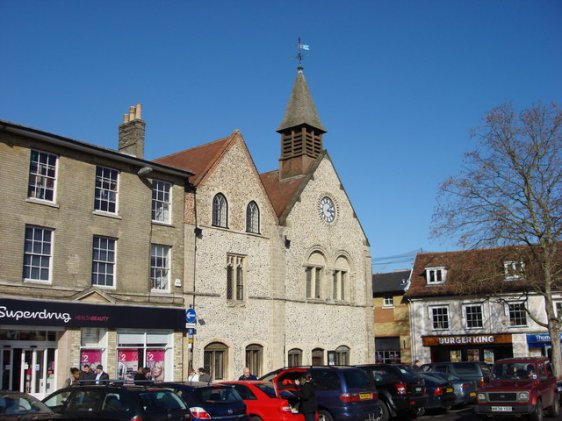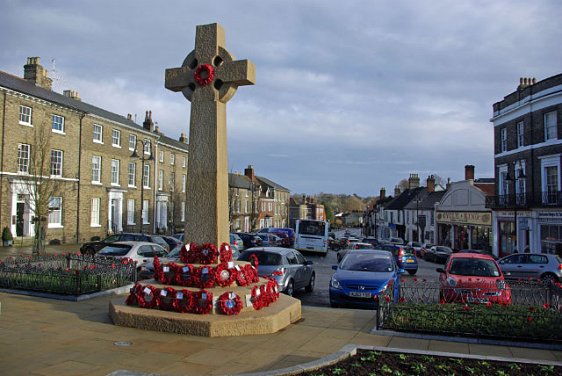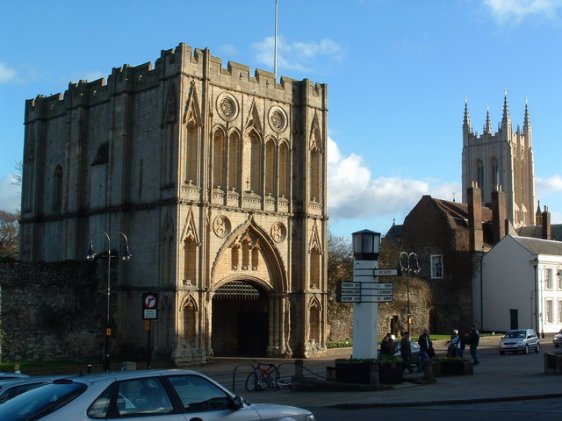 Moyse's Hall Museum in Bury St Edmunds, Suffolk, England: Source: https://commons.wikimedia.org/wiki/File:Moyse%27s_Hall_museum_-_geograph.org.uk_-_742343.jpg
Moyse's Hall Museum in Bury St Edmunds, Suffolk, England: Source: https://commons.wikimedia.org/wiki/File:Moyse%27s_Hall_museum_-_geograph.org.uk_-_742343.jpgAuthor: Oxyman

Bury St Edmunds is a market town in Suffolk, England. Formerly the county town of West Suffolk, it is today the main town of the borough of St Edmundsbury. The town has a population of around 36,000 people (2012 estimate). It is often known locally simply as Bury.
Human settlement in the Bury St Edmunds area goes back to the Roman period and probably even earlier, though the history of Bury St Edmunds only began in the 7th century, when Sigebert, king of the East Angles founded a monastery there. In those days, the settlement was called Beodricsworth. On 20 November 869 the Christian King Edmund was captured and tortured to death by invading Great Heathen Army of the Danes. The relics of the martyred king were translated from Hoxne to Beodricworth, which was then renamed St Edmundsbury. The abbey where the king was buried also became known as the Bury St Edmunds Abbey.
The shrine holding the relics became a famous pilgrimage site in medieval England. Except for a three-year period in 1010, when the relics were translated to London for safekeeping from raiding Vikings, they were at Bury St Edmunds Abbey until the English Reformation and Dissolution of the Monasteries in 1539, when the shrine was destroyed, the monks expelled and the abbey dissolved.
 War Memorial at Bury St Edmunds: Source: https://commons.wikimedia.org/wiki/File:Mustow_Street,_Bury_St_Edmunds_-_geograph.org.uk_-_1610183.jpg
War Memorial at Bury St Edmunds: Source: https://commons.wikimedia.org/wiki/File:Mustow_Street,_Bury_St_Edmunds_-_geograph.org.uk_-_1610183.jpgAuthor: Stephen McKay

In addition to its namesake, Bury St Edmunds is also associated with the Magna Carta, which the barons of England forced upon King John to proclaim certain liberties. The town grew from strength to strength over the centuries. In 1235 it was granted a charter to hold two annual fairs by King Henry III. By the 14th century it had developed into a thriving center for cloth weaving.
In the early 17th century, the borough of Bury St Edmunds was sympathetic to Puritan sentiments. As such, a number of families there left England to join the Massachusetts Bay Colony during the Great Migration. While other towns developed during the Industrial Revolution, Bury fell into relative decline during that time. Today it is home to the largest British-owned brewery, Greene King, and Britain's smallest pub, The Nutshell.
Visiting Bury St Edmunds
From London, take the M11 motorway to Junction 9 then continue heading northeast on the A11 road. It joins the A14 road at Newmarket before branching off at Junction 38. Keep on the A14 road to reach Bury St Edmunds. Abbeygate and St Edmundsbury Cathedral: Source: https://commons.wikimedia.org/wiki/File:Angle_Hill_Bury_St.Edmunds_-_geograph.org.uk_-_318411.jpg
Abbeygate and St Edmundsbury Cathedral: Source: https://commons.wikimedia.org/wiki/File:Angle_Hill_Bury_St.Edmunds_-_geograph.org.uk_-_318411.jpgAuthor: Keith Evans

Places of Interest in Bury St Edmunds
- Moreton Hall: 18th century country house built in 1773 and now a Grade II* listed building. It today serves as a co-educational preparatory school.
- Moyse's Hall Museum: Museum housed in a ca. 1180 building. It is one of the oldest domestic buildings that is open to the public. The museum displays collections of fine art and items related to the town's social history.
- Theatre Royal, Bury St Edmunds: Restored Regency theater, one of eight Grade I listed theaters in the United Kingdom, and the only working theater belonging to the National Trust.
- St Edmundsbury Cathedral: Seat of the Bishop of St Edmundsbury and Ipswich. It was built within the precincts of the Bury St Edmunds Abbey, which was destroyed during the Dissolution of the Monasteries.
- St Mary's Church: Church were Mary Tudor, Queen of France and sister to King Henry VIII was reburied six years after her death.
 Latest updates on Penang Travel Tips
Latest updates on Penang Travel Tips

Copyright © 2003-2025 Timothy Tye. All Rights Reserved.

 Go Back
Go Back